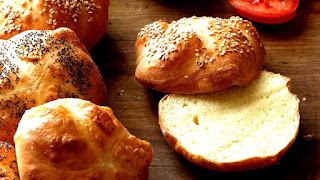The Kaiser roll (Emperor roll, German: Kaisersemmel), also called a Vienna roll (Wiener Kaisersemmel; as made by hand also: Handsemmel, Slovene: kajzerca) or a hard roll, is a typically crusty round bread roll, originally from Austria. It is made from white flour, yeast, malt, water and salt, with the top side usually divided in a symmetric pattern of five segments, separated by curved superficial cuts radiating from the centre outwards or folded in a series of overlapping lobes resembling a crown. The crisp Kaisersemmel is a traditional Austrian food officially approved by the Federal Ministry of Agriculture.
Semmel (derived from Latin: simila, wheat flour) is the common name for any kind of roll in Austria and the German state of Bavaria, equivalent to Brötchen in Northern Germany or Weck in Baden-Württemberg.
Video Kaiser roll
Origin
Kaiser rolls have existed in a recognizable form at least since 1760. They are thought to have been named to honor Emperor (Kaiser) Franz Joseph I of Austria (born 1830, reigned 1848-1916). In the 18th century a law fixed retail prices of Semmeln (bread rolls) in the Habsburg Monarchy. Allegedly, the name Kaisersemmel came into general use after the bakers' guild sent a delegation in 1789 to Emperor Joseph II (b. 1741, r. 1765-1790) and convinced him to deregulate the price of bread rolls.
With its monarchical connotation, Kaiser rolls stood out against common rolls known as Mundsemmeln ("mouth rolls") or Schustersemmeln ("cobbler's rolls"). They are traditionally found in Austria, but have also become popular in other countries of the former Austrian Habsburg Empire, such as the Galicia region in Poland (where it is known as kajzerka), Croatia, Slovenia, and Serbia (kajzerica), Hungary (császárzsemle), the Czech Republic (kaiserka), as well as in Germany, the United States, and Canada. During Austrian rule in Lombardy, Italian bakers produced a hollow version known as michetta or rosetta.
Maps Kaiser roll
Variations
A handmade Kaiser roll is known as a Wiener Kaisersemmel (Handsemmel) according to the Codex Alimentarius Austriacus standards collection.
There are multiple variants of the common roll, differing in size, type of flour used, and toppings. While traditionally plain, Kaiser-style rolls are today found topped with poppy seeds, sesame seeds, pumpkin kernels, linseed, or sunflower seeds. The Kaiser roll is a main part of a typical Austrian breakfast, usually served with butter and jam. It is often used as a bun for such popular sandwiches as hamburgers in America, and with a slice of Leberkäse in Germany (and Austria itself), though sliced Extrawurst and pickled gherkins (Wurstsemmel), or a type of Wiener Schnitzel (Schnitzelsemmel) are also used. A variation called a Kimmelweck is topped with kosher salt and caraway, and in the United States is an essential component of a Buffalo-area specialty, the beef on weck sandwich.
See also
- Vienna bread
- Austrian cuisine
- List of bread rolls
References
External links
- New York Folklore Society - Buffalo's Other Claim to Fame
Source of the article : Wikipedia

